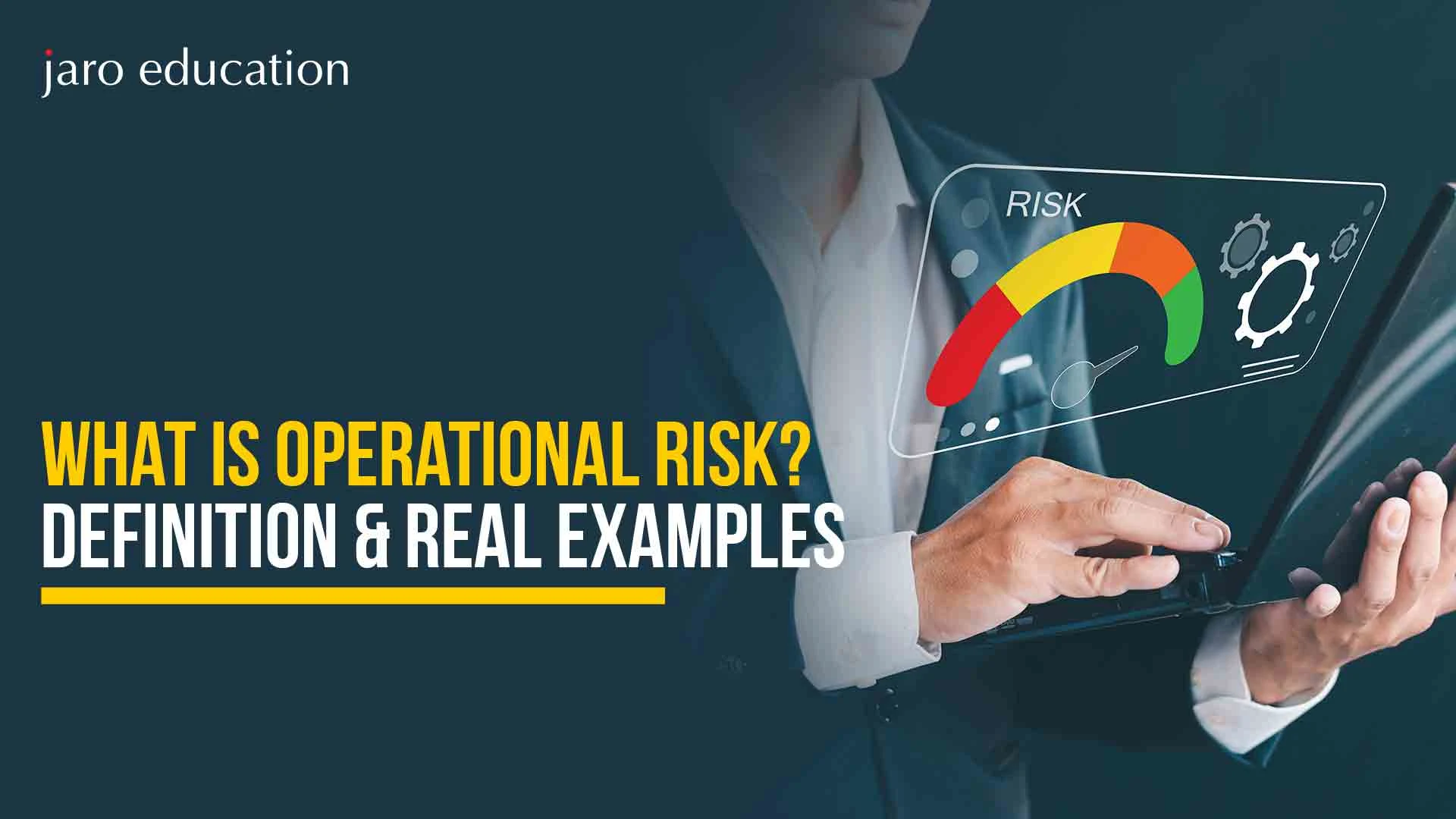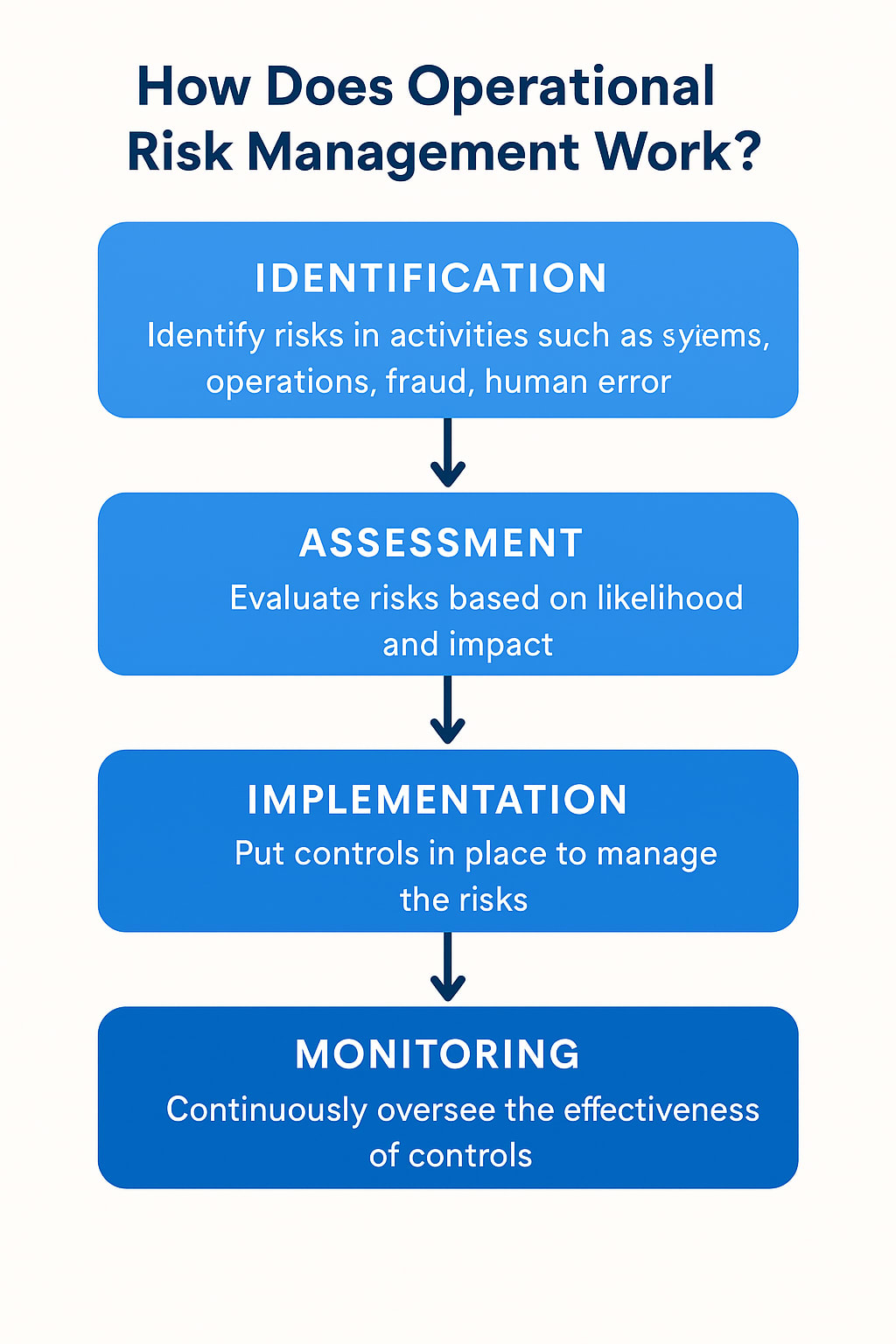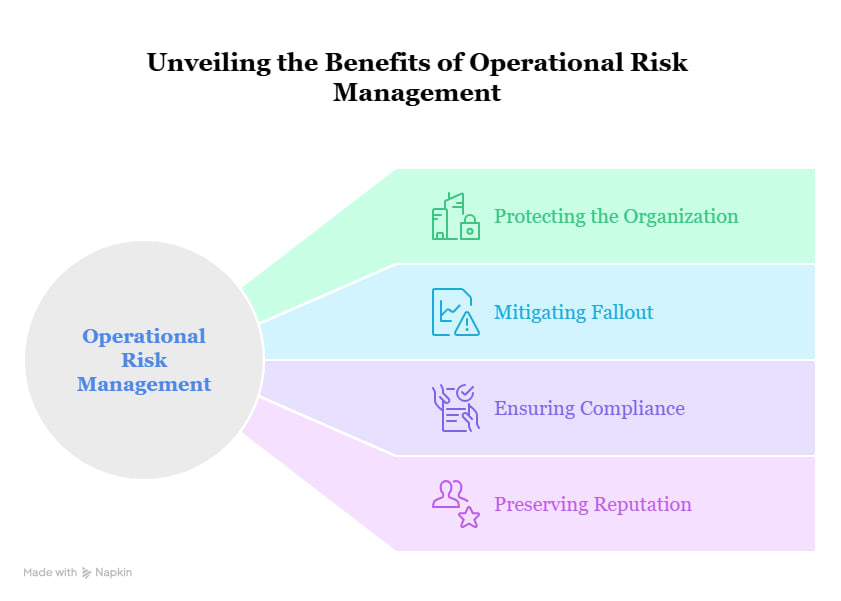What Is Operational Risk? Definition & Real Examples
Table of Contents

- jaro Education
- 10, May 2024
- 10:00 am
Operational risk is more than a back-office problem; it can be a silent threat that can cause catastrophic business disruption in seconds. Operational risks include cyberattacks, fraud, system failure, non-compliance, and other types of operational risks that cost businesses globally over $100 billion per year in losses and reputational harm.
Most organizations fail to recognize that operational risk exists in their business, or, when they do realize that a risk exists, take a long time to react.
That’s where Operational Risk Management (ORM) comes into play. ORM is more than damage control; it is about building resilience, being able to make better decisions, protecting customer trust, and your future business sustainability.
What is Operational Risk Management?
Operational risk is the risk of operational failure or an organizational breakdown ultimately arising from failed internal processes, human error, poor policies, system failures, and external events. While operational risk is ultimately about you managing risk in an organization, the incident or organizational failure could be external.
What is the Impact of Operational Risk on your Organization?
Every organization is subject to operational risk regularly simply by conducting business. As business operations get more complicated, the probability of something slipping through the cracks, policies collecting dust on a shelf or not being communicated as the workforce matures, or controls that are not sustained and monitored will gradually fail.
These all increase operational risk exposure over time, which leads to an increased likelihood as well that operational risk will occur and impact your revenue or brand reputation.
How Does Operational Risk Management Work?

Operational Risk Management (ORM) is used by organizations to identify potential risks before they occur so they can take action to either prevent those risks from occurring or, at a minimum, minimize the increase in operational risk. ORM begins with the identification of risks associated with their normal day-to-day activities (e.g., systems, operations, fraud, human error, etc.). Once the risk is identified, it is then assessed in terms of likelihood and impact.
Once the risk has been assessed, the organization puts controls into place to mitigate or manage those identified risks (policies, training, technology, etc.). These controls go through ongoing monitoring to determine how effective they are in mitigating the risks and to determine if they should be revised or enhanced. As you go through these steps, there will be increased documentation, as your teams will need to keep track of all information about the process for continuous improvement. In short, ORM is about avoiding problems in the first place through proper planning and early action!
Real-Life Examples of Operational Risk Management
Operational risk management (ORM) is essential in avoiding loss and ensuring smooth operations. Here are a couple of examples in real life of how some companies practically use ORM:
- Banking—Fraud:
A large bank uses multi-level authentication and reviews transactions in real-time to detect anomalous activity. This allows the bank to prevent internal fraud and prevent external fraud from winning over clients’ accounts, saving potentially millions of dollars in losses.
- Retail—System Failures:
A big retail e-commerce platform conducts system checks every month, which includes a backup server. When the server goes down in the middle of a flash sale (on the busiest day of the year), the systems switchover is seamless, and downtime is avoided because operations can continue without the customers even knowing.
- Health—Compliance:
An organization provides training to all staff on data privacy legislation (e.g., HIPAA), and all patient data is put into an encrypted system. No accidental legal expenditure through bad compliance through proper ORM methods, coupled with good practice.
- Manufacturing—Safety:
A manufacturing organization identifies that a machine routinely overheats. As a safety measure, the organization considers something like ongoing maintenance and training for team members to avoid risk, but also any fiscal impacts for the business.
Common Operational Risk Challenges & Solutions
Managing operational risk helps organizations protect themselves from unanticipated issues, but not always without a struggle. Many organizations face similar obstacles to adequately managing their risks.
Here are some of the most common challenges—and some straightforward solutions to overcome them:
| Challenge | Explanation | Solution |
| 1. Lack of Resources | Not enough tools, staff, or budget for proper risk management | Allocate dedicated resources for risk assessment, monitoring, and reporting. |
| 2. Low Awareness | Employees and teams don’t understand the importance of managing risks | Conduct training and raise awareness about the financial and operational impact of risks. |
| 3. Limited Leadership Support | Top management doesn’t prioritize operational risk | Share real-world case studies to gain buy-in from leadership and the board. |
| 4. No Standard Risk Measurement | Inconsistent methods make it hard to assess and compare risks. | Use standardized frameworks or scoring systems for risk evaluation |
| 5. Confusing Risk Language | Different teams use different terms, causing miscommunication. | Develop a common risk glossary and ensure everyone uses the same terms. |
| 6. Complex Technology | New tools and systems introduce new types of risks | Involve IT in risk discussions and regularly update your risk strategy. |
| 7. Overlap with Other Functions | Risk gets mixed up with compliance or IT and loses focus. | Clearly define roles and integrate risk management without overlap |
| 8. Disorganized Risk Programs | Programs are rushed to meet regulations and lack structure. | Build a long-term, structured risk plan with regular updates and reviews |
Benefits of Operational Risk Management You Should Know

A successful ORM program prioritizes protecting the organization. ORM takes a much more risk-averse stance versus the wider traditional ERM program, which considers risk and reward together. It is chiefly concerned with mitigating any fallout should risks materialize.
Examples of fallout include;
Disrupting operations,
Financial failures,
Non-compliance, and
Damaging reputation.
ORM is an organizational function of business-critical necessity that provides a significant number of benefits.
5 Stages of Operational Risk Management Framework
Although there are diverse methods of applying the ORM process steps, Operational Risk Management is mostly used as a five-phase process. Each of the five phases is essential and necessary to be conducted. The five phases of ORM include:
Phase 1: Risk Identification
The first step is to identify risk so it can be managed. The identification of risk starts by learning the organization’s objectives. In this context, risks are anything that diminishes an organization’s ability to achieve its objectives.
Process Analysis: Reviewing the internal processes of the organization (production, IT, HR, customer service, etc.) to identify possible fail points and/or lapses in process.
Loss Data Review: The review of the organization’s historical loss data to identify trends and areas of concern (financial loss, hacking, compliance violations, or any incidents that impacted operations).
Risk Workshops and Interviews: Engaging employees at varying levels within the organization to conduct workshops or interviews to gather their experiences – perceived risks, opportunities for improvement, and past incidents.
External Event Review: Evaluating outside events that might impact the organization through change. This includes generally accepted trends in the industry, changes in the implementation of regulations/laws, advancements in technology, and other external events such as geopolitical events.
Scenario Analysis: Developing hypothetical scenarios to analyze risks and their implications. This also engages the concept of resilience and if the organization is prepared for unlikely odds with traction.
Step 2: Risk Assessment
Risk Assessment is a structured, repeatable method for ranking risks according to their likelihood and impact. There will be an outcome from the risk assessment, which is a ranked list of known risks, also known as the risk owner and risk mitigation plan, that is simply referred to as a risk register. It may not be feasible nor advisable for an organization to address all identified risks; thus, prioritization is important for the management of operational risk and points project teams to focus on those risks that are most significant. This risk assessment process may look like the risk assessment of the internal audit, and this should be informed by previous audit reports and findings.
Step 3: Risk Mitigation
The risk mitigation step of the process includes the development and selection of a course of action for the controls for specific risks. There are four ways to address potential risk events if a risk event is defined in the Operational Risk Management process: transfer, avoid, accept, and mitigate.
Transfer: Transferring means shifting the risk to another organization. The two most common means for transferring are outsourcing and insuring. When management outsources, the organization is never able to fully transfer the responsibility for controlling risk. Insuring against the risk does transfer some of the financial impacts of the risk to the insurance company.
Avoidance: Avoiding risk means the organization does not have the opportunity to enter into a high-risk situation or environment. For example, when selecting a vendor to provide you a service, the organization could choose to accept a vendor with a higher-priced bid if the lower-priced vendor did not have enough references to assure the organization of their ability to perform the service.
Accept: Based on the assessment of the risk to the cost of mitigation, management could choose to accept the risk and accept the high-risk scenario. There is again an example, and that is the requirement to assess the risk of an employee hurting themselves from using new coffee makers in the break room. In this case the outstanding benefits to employee satisfaction outweighed the risk of a potential employee burning themselves using hot coffee, and management therefore accepted the risk and put in new coffee makers.
Mitigate: Action plans and control implementation in relation to risks will mitigate them by decreasing their likelihood and/or the impact if the risk were to occur. For example, if an organization has a policy to allow employees to work from home, there would be a risk of data leaking when data is transmitted across the public internet.
Step 4: Control Implementation
Once risk mitigation decisions have been reached, action plans are drafted, and residual risk is documented, the next step is implementation. Controls should be designed specifically to treat and mitigate the addressed risk. The rationale, objective, and activity related to the control should be formally documented so controls can be communicated and put into practice. Controls can appear in many forms: a process, an additional approver, system controls, or a combination of all three, for example, to limit the end user from making mistakes or conducting malicious acts. Whenever possible, controls should be designed to be preventive instead of detective or corrective. Just like risk management and medicine, the best option is going to be prevention. Still, specific risks may be impossible to prevent, which is where the role of detective controls is utilized. Detecting some inconsistency and then correcting it may be enough to mitigate some risks.
Your organization likely has some controls implemented to address risks! It’s still a good idea to annually review those controls (at a minimum) and assess those controls (if they have holes, implement additional controls) or if the controls are sufficient to address the risk and require no modifications.
Step 5: Monitoring
As controls may involve people making mistakes or have the potential to change, controls need to be monitored. Control monitoring includes assessing if the control is appropriately designed and that it is operating effectively. Any exceptions or issues need to be escalated to appropriate management with an action plan in place.
Within the Operational Risk Management strategy’s monitoring step, some organizations, particularly in financial services, have integrated continuous monitoring or early warning systems around key risk indicators (KRIs). Key risk indicators are measures used by organizations to provide an early warning signal of an increased risk exposure in various areas of the organization. KRIs designed around ratios monitored by business intelligence applications are how banks manage operational risk; however, the concept can be applied in any industry. KRIs can be designed to monitor almost any risk, which can be sent as a notification. As an example, a company could design a key risk indicator around customer satisfaction scores. A decline in customer satisfaction scores could indicate that customer service representatives are not being trained or that the training is not effective.
Career in Operational Risk Management: How to Start
The Online MBA Degree Programme Symbiosis School for Online and Digital Learning (SSODL) is designed for individuals seeking to enhance their strategic intelligence and pursue an excellent corporate career. This program offers learners the opportunity to equip themselves with the skills and knowledge required to be contemporary and effective leaders in today’s rapidly changing business environment. Learn from the globally recognized institution to develop the knowledge that will make professionals stand out globally in these challenging times. The curriculum is created by leading B-School experts of Symbiosis, and it is taught by competent faculty, ensuring that students receive the highest quality education. Specializations include Marketing, HR, Finance, Operations, Business Analytics, International Business, Hospital and Healthcare Management, Agri Operations Management, Logistics and Supply Chain Management. Advance your professional growth, acquire the skills and knowledge in high demand in today’s job market, and achieve your career aspirations.
How Jaro Education Helps You Choose the Right Career Path
Jaro Education simplifies the process of selecting a career path for working professionals and students alike by offering industry-relevant online programs with leading universities and institutes. With extensive career counseling from industry experts, individualized career coaching, and access to globally recognized programs, learners of all backgrounds can acquire in-demand skills for today’s tough labor market. Many students have also successfully transitioned to a different career, received a promotion, or moved into a leadership position after pursuing Jaro’s programs, demonstrating that the right guidance and education can yield tangible results.
Conclusion
Operational Risk Management (ORM) is no longer a box-ticking regulatory obligation or a back-office function but rather a critical business process that directly affects an organization’s resilience, reputation, and revenues. As operational risks present themselves from evolving technology, globalization, and complex ways of working, organizations should take a proactive approach to identifying, assessing, and mitigating operational risks before they evolve into severe disruption.
Implementing a structured ORM process not only reduces the risk of vulnerabilities but can also facilitate better decisions, enhance customer trust, and develop long-term sustainable practices. If you are in the early stages of your operational risk career or developing your capabilities, programs such as the Online MBA from Symbiosis through Jaro Education can provide you with the strategic advantage to navigate the risk-aware landscape of today.
By investing in operational risk management today, you are investing in a more secure, stable, and successful future.
Frequently Asked Questions
The five steps in Operational Risk Management (ORM) are:
- Risk Identification—Recognizing potential risks that could impact business operations.
- Risk Assessment—Analyzing the likelihood and impact of each risk.
- Risk Mitigation—Choosing strategies to reduce, transfer, avoid, or accept the risk.
- Control Implementation—Putting in place controls or safeguards to manage the risk.
- Monitoring—Regularly checking the effectiveness of controls and updating them as needed.
Operational Risk Management (ORM) focuses specifically on risks arising from internal processes, human errors, systems, or external events that disrupt operations.
Enterprise Risk Management (ERM) is broader — it covers all types of risks (strategic, financial, reputational, operational) and balances risk with potential rewards to meet organizational goals.
An example of operational risk is a cyberattack on a bank’s system that causes customer account data to be compromised. This can result in financial loss, regulatory penalties, and damage to reputation.
Operational risk management is important because it helps organizations prevent disruptions, protect revenue, ensure compliance, and safeguard brand reputation. It allows businesses to respond quickly to threats and maintain continuity even during unexpected events.
Some common challenges include:
- Lack of resources or budget
- Low awareness among employees
- Limited support from leadership
- Inconsistent risk measurement methods
- Complex technology systems
- Overlap with other functions like compliance or IT
- Disorganized or rushed ORM programs
These challenges can be addressed through structured planning, leadership support, training, and standardized frameworks.
Recent Blogs
It seems we can't find what you're looking for.







